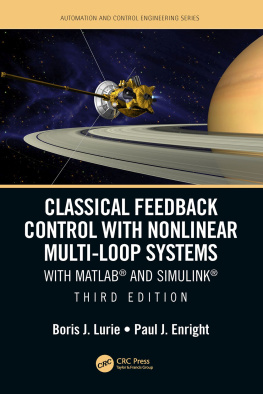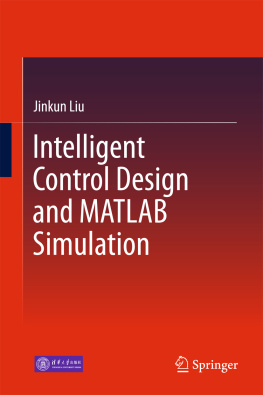Springer Tracts in Mechanical Engineering
Series Editors
Seung-Bok Choi
College of Engineering, Inha University, Incheon, Korea (Republic of)
Haibin Duan
Beijing University of Aeronautics and Astronautics, Beijing, China
Yili Fu
Harbin Institute of Technology, Harbin, China
Carlos Guardiola
CMT-Motores Termicos, Polytechnic University of Valencia, Valencia, Spain
Jian-Qiao Sun
University of California, Merced, CA, USA
Young W. Kwon
Naval Postgraduate School, Monterey, CA, USA
Francisco Cavas-Martnez
Departamento de Estructuras, Universidad Politcnica de Cartagena, Cartagena, Murcia, Spain
Fakher Chaari
National School of Engineers of Sfax, Sfax, Tunisia
Francesca di Mare
Institute of Energy Technology, Ruhr-Universitt Bochum, Bochum, Nordrhein-Westfalen, Germany
Hamid Reza Karimi
Department of Mechanical Engineering, Politecnico di Milano, Milan, Italy
Springer Tracts in Mechanical Engineering (STME) publishes the latest developments in Mechanical Engineering - quickly, informally and with high quality. The intent is to cover all the main branches of mechanical engineering, both theoretical and applied, including:
Engineering Design
Machinery and Machine Elements
Mechanical Structures and Stress Analysis
Automotive Engineering
Engine Technology
Aerospace Technology and Astronautics
Nanotechnology and Microengineering
Control, Robotics, Mechatronics
MEMS
Theoretical and Applied Mechanics
Dynamical Systems, Control
Fluids Mechanics
Engineering Thermodynamics, Heat and Mass Transfer
Manufacturing
Precision Engineering, Instrumentation, Measurement
Materials Engineering
Tribology and Surface Technology
Within the scope of the series are monographs, professional books or graduate textbooks, edited volumes as well as outstanding PhD theses and books purposely devoted to support education in mechanical engineering at graduate and post-graduate levels.
Indexed by SCOPUS, zbMATH, SCImago.
Please check our Lecture Notes in Mechanical Engineering at https://link.springer.com/bookseries/11693 if you are interested in conference proceedings.
To submit a proposal or for further inquiries, please contact the Springer Editor in your region:
Ms. Ella Zhang (China)
Email: ella.zhang@springernature.com
Priya Vyas (India)
Email: priya.vyas@springer.com
Dr. Leontina Di Cecco (All other countries)
Email: leontina.dicecco@springer.com
All books published in the series are submitted for consideration in Web of Science.
More information about this series at https://link.springer.com/bookseries/11693
Ning Ji and Jinkun Liu
Boundary Control of Flexible Three-Dimensional EulerBernoulli Beams

Logo of the publisher
Ning Ji
School of Automation Science and Electrical Engineering, Beihang University, Beijing, China
Jinkun Liu
School of Automation Science and Electrical Engineering, Beihang University, Beijing, China
ISSN 2195-9862 e-ISSN 2195-9870
Springer Tracts in Mechanical Engineering
ISBN 978-981-19-0078-5 e-ISBN 978-981-19-0079-2
https://doi.org/10.1007/978-981-19-0079-2
The Editor(s) (if applicable) and The Author(s), under exclusive license to Springer Nature Singapore Pte Ltd. 2022
This work is subject to copyright. All rights are solely and exclusively licensed by the Publisher, whether the whole or part of the material is concerned, specifically the rights of translation, reprinting, reuse of illustrations, recitation, broadcasting, reproduction on microfilms or in any other physical way, and transmission or information storage and retrieval, electronic adaptation, computer software, or by similar or dissimilar methodology now known or hereafter developed.
The use of general descriptive names, registered names, trademarks, service marks, etc. in this publication does not imply, even in the absence of a specific statement, that such names are exempt from the relevant protective laws and regulations and therefore free for general use.
The publisher, the authors and the editors are safe to assume that the advice and information in this book are believed to be true and accurate at the date of publication. Neither the publisher nor the authors or the editors give a warranty, expressed or implied, with respect to the material contained herein or for any errors or omissions that may have been made. The publisher remains neutral with regard to jurisdictional claims in published maps and institutional affiliations.
This Springer imprint is published by the registered company Springer Nature Singapore Pte Ltd.
The registered company address is: 152 Beach Road, #21-01/04 Gateway East, Singapore 189721, Singapore
Preface
Compared with rigid materials, flexible materials have the advantages of lightweight, low-energy consumption and flexible operation, which are widely applied in aerospace, seabed exploration, medical industry, robotics, machinery manufacturing and other fields. The mechanical systems made of flexible materials are also different from the systems made of rigid materials. The rigid mechanical systems are traditional lumped parameter systems, and the models can be described by ordinary differential equations (ODEs). While the flexible mechanical systems are typical distributed parameter systems, the model states are not only related to time, but also to spatial position, so they should be described by partial differential equations (PDEs) more precisely. The flexible mechanical systems have some advantages mentioned above, but it inevitably leads to vibration because of the flexibility in the process of working. Therefore, vibration suppression is a key problem to be solved in order to ensure the normal operation of the flexible mechanical systems.
Typical distributed parameter systems include flexible manipulators, flexible satellite panels, flexible aircraft wings, flexible aerial refueling hose and flexible marine riser. Due to the fact that the above mechanical systems have slender structures, they are usually regarded as EulerBernoulli beams for dynamic modeling. Meanwhile, in order to meet the actual working environment, the deflections of an EulerBernoulli beam are considered in three-dimensional space in this book. The PDEs of flexible three-dimensional mechanical systems are more complex than those of plane systems, and there are strong couplings between deflections in three directions, which brings more challenges to the control law design and stability analysis.
Based on PDEs of a flexible three-dimensional EulerBernoulli beam, the book is structured as follows:
Chapter is the introduction section. Some specific examples of mechanical systems are listed for illustrating the application background and research significance of three-dimensional EulerBernoulli beams. Then modeling methods, control strategies and control methods, stability analysis and simulation methods are introduced for distributed parameter systems. Finally, a series of common practical engineering problems are introduced which will be considered in this book.










